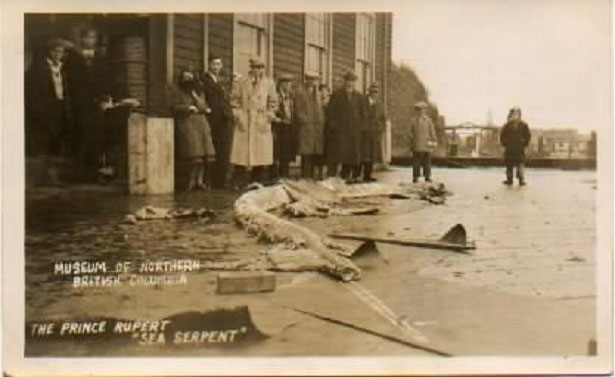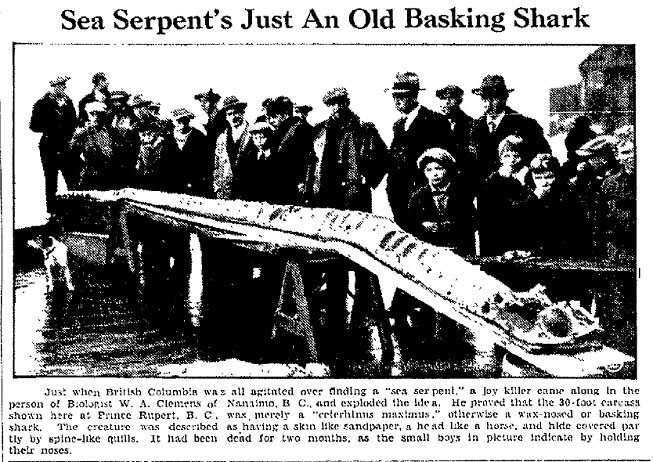
August 18, 2010

Let’s reexamine this case in light of the new footage.
Galveston Daily News
Galveston, Texas, USA
1934 November 24, page 13
Carcass of Strange Marine Creature Found on Pacific
Prince Rupert, B. C., Nov. 23. – AP
Amid the “I told you so” remarks of persons who in recent years had reported seeing enormous serpents cavorting the Pacific hereabouts, scientists sought today to restore to its origins! appearance the emaciated carcass of a strange monster found by a fisherman.
The creature apparently had been about 30 feet long, with a skin like sandpaper, a head resembling that of a horse and a hide partly covered by hair and partly by spines or quills.
Scientific classifications indicated the creature might have resembled the ichthyosaurus or the proteosaurus, an order of extinct marine creatures known to have existed in the mesozoic age, when animal life on earth supposedly progressed from flashes to reptiles.
The monster, discovered by H. Sunderstrom, a fisherman, appeared after a long series of reports by fishermen, ship captains and other seemingly reliable sources that three sea serpents had been seen along the Pacific coast many times in the last two years.
Dr. Neal Carter, director of the dominion fisheries experimental station, who brought the carcass here, said the creature had been dead about two months.
His description of the remains was exactly like that of several persons who reported seeing a swimming sea serpent in the Jordan River shortly after Easter.
The monster was popularly called “Jorda” by the Canadians, who said it must be the daughter of “Hiaschuckalick Cadborosaurus,” the 80-foot serpent, and his mate, “Penda,” a 60-foot monster, both of which had been reported seen by hundreds of persons during the two-year period.
Dr. Carter’s monster apparently resembles no species of marine life heretofore known in these waters, scientists said. They added that no attempt to classify it would be made until an intelligent reconstruction had been made.
“In life it must have been slender and sinewy,” said Dr. Carter. “The remains were lying on the beach of Henry Island, which is north of Vancouver Island. Possibly it was left stranded in the inlet, trapped by the rocks when the tide went down; it might have fled there to escape some unknown enemy, or have gone there to die of old age.
“Sea gulls had been feeding upon the flesh, and about all that was left was skin, sinews, hair and quills and a somewhat elevated backbone.”
Dr. Carter said there probably were no bones, except the backbone. The flesh clinging to it was red, which he said would put it definitely out of the fish class and into that of the mammalia. He expressed the opinion it was a deep sea dweller.
The only evidences of external appendages were four fins or flapperlike projections of cartilagenous material about four feet long, one pair about four feet from the head, another about 20 feet lower. Only two of the fins remained attached.
The Emporia Gazette
Emporia, Kansas, USA
1934 November 22, page 2
Sea Monster Found.
Remains of Strange Animal Studied By a Scientist.
Prince Rupert, B. C., Nov. 22 (AP) – The remains of a strange marine monster were studied today by Dr. Neal Carter, director of the Prince Rupert dominion fisheries experimental station. Found on the beach of Henry Island, lies south of here, the remains were partially decomposed.
Dr. Carter announced:
1. The creature was about 30 feet long.
2. Red flesh indicated it was some sort of a warm-blooded marine animal.
3. It had a head shaped somewhat like that of a horse, and a tough, rough skin.
4. The upper part of the skin bore hair and the lower part quills. like spines.
5. The only bone of importance was the backbone.
The find was made within a few hundred miles of the playground of Amy Cadborosaurus, Britrish Columbia’s most popular sea serpent, often reported cavorting about ocean inlets on southern Vancouver Island, and once the object of a quest of scientists from Seattle.
))))))))
Lessons are to be learned from the so-called “Henry Island Carcass” or “Prince Rupert Sea Serpent” of 1934.

So what did this turn out to be?
Only days later what has been credited as Dr. Carter was able to identify the carcass (also known as Henry Island Carcass) as Cetorhinus maximus, the world’s second largest known shark, the basking shark.
Craig Hainselman has written a well-researched article including images and news articles in the BioFortean Review of November 2006, entitled “Zaweaksh, The Prince Rupert 1934 Sea-Monster.”

According to the articles and Heuvelmans, according to Markus, instead it was Dr. Clemens from the Government Biological Station at Nanaimo. Dr. Carter has thought first that it was a mammal. But as Dr. Clemens analyzed parts of the backbone and the skull he identified it as C. maximus. Others still said it could be a Steller Sea Cow (Hydrodamalis stelleri). As Heuvelmans points out the Illustrated London News reproduced a picture of the monster with skeletons of a Sea Cow and a basking shark (see plates 15, 16, 17 ofIn the Wake…). What do you think which one is more similiar?
Markus goes on and notes that a lesson someone has to learn dealing with such carcasses is that the press or the people nearly always titles such a carcass as “Sea Monster” or something (consider that in this case Caddy arised a short time before and was in everyone’s mind). For example, the carcass of Ataka (a Bryde’s whale) was a “Sea Elephant,” “Sea Monster”. The Egyptian experts also couldn’t identify it first but later announced his real identity.
Markus of the German Kryptozoologie is to be thanked for bringing this online resource to our attention and his helpful comments.
About Loren Coleman
Loren Coleman is one of the world’s leading cryptozoologists, some say “the” leading living cryptozoologist. Certainly, he is acknowledged as the current living American researcher and writer who has most popularized cryptozoology in the late 20th and early 21st centuries.
Starting his fieldwork and investigations in 1960, after traveling and trekking extensively in pursuit of cryptozoological mysteries, Coleman began writing to share his experiences in 1969. An honorary member of Ivan T. Sanderson’s Society for the Investigation of the Unexplained in the 1970s, Coleman has been bestowed with similar honorary memberships of the North Idaho College Cryptozoology Club in 1983, and in subsequent years, that of the British Columbia Scientific Cryptozoology Club, CryptoSafari International, and other international organizations. He was also a Life Member and Benefactor of the International Society of Cryptozoology (now-defunct).
Loren Coleman’s daily blog, as a member of the Cryptomundo Team, served as an ongoing avenue of communication for the ever-growing body of cryptozoo news from 2005 through 2013. He returned as an infrequent contributor beginning Halloween week of 2015.
Coleman is the founder in 2003, and current director of the International Cryptozoology Museum in Portland, Maine.
Filed under Cadborosaurus, Cryptomundo Exclusive, CryptoZoo News, Cryptozoology, Eyewitness Accounts, Sea Serpents, Year In Review